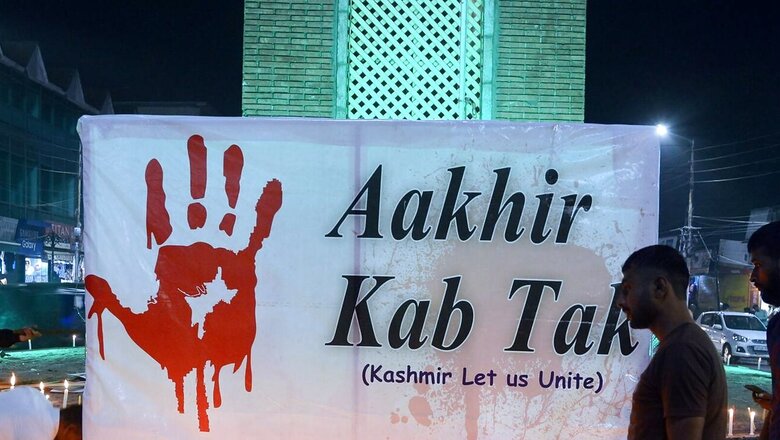
views
The Union Territory of Jammu and Kashmir has seen a sudden wave of targeted killings of civilians in recent days. According to the Jammu and Kashmir police data, a total of 28 civilians have been killed by terrorists in the Valley this year. Over the past two weeks, in October alone, 11 civilians and nine Army personnel have been killed in the Kashmir valley. The targeted civilians include Kashmiri Pandits, a Sikh, and migrant labourers.
Makhan Lal Bindroo, an eminent Kashmiri Pandit, a community leader and a well-known pharmacist who refused to leave Jammu and Kashmir at the peak of militancy was brutally murdered by terrorists. School principal Satinder Kaur and teacher Deepak Chand were killed within the school premises. Harmless migrants from Bihar, who were earning an honest living in Jammu and Kashmir in a peaceful manner, were not spared either.
A terrorist group, The Resistance Front (TRF), has claimed responsibility for these gruesome killings. The TRF has warned Kashmiri Pandits, Sikh families and migrant labourers to leave Kashmir. Owing to fear, these people have started moving out of the Valley, mainly to Jammu. Simultaneously, the district authorities, on the request of the Jammu and Kashmir Police, have started shifting many non-local labourers to secure locations on an ‘urgent’ basis.
The Resistance Front: New Terrorist Group in Jammu and Kashmir
The TRF was born after the revocation of Article 370 and Article 35A of the Indian Constitution on August 5, 2019 as a response to stripping away of Jammu and Kashmir’s autonomous status and the special rights and privileges Kashmiris enjoyed before the revocation. The members of the TRF deliberately maintain a low profile, unlike other terrorist groups, to avoid being vulnerable. They are making use of social media to spread their propaganda.
ALSO READ | This is How India Can Counter Pakistan’s Dangerous Revival Game in Kashmir
The officials of National Investigation Agency (NIA) suggest that the TRF is an offshoot of the Lashkar-e-Taiba (LeT) and has been created by Pakistan with the objective to make terrorist groups in Kashmir look like indigenous outfits. They are being supported financially by Pakistan. Since its inception, the TRF has mainly targeted Kashmiri Pandits and Sikhs and has warned of more such attacks on minorities in the future to force them to leave Kashmir.
Are These Killings Acts of Militancy or Terror?
Unsurprisingly, the local parties—the Peoples Democratic Party and the National Conference—were quick to justify these killings as acts of militancy as opposed to terrorist attacks. The reasons for such a justification would be to trivialize the recent killings and to appease the majority community in the Valley, aimed at garnering more votes in the upcoming elections in Jammu and Kashmir. However, I am of the view that these were not isolated killings but targeted, systematic acts of terror to create fear among the minority communities to force them to leave Kashmir.
This raises several questions. Were the migrant labourers killed to divert the attention from the killings of Kashmiri Pandits and a Sikh in the Valley? Are Kashmiri Pandits now considered ‘migrants’ within the Valley? These questions need further deliberation to understand the mindset of terrorist organizations and to put an end to the killings of innocent civilians.
Why are Minorities Being Targeted Now?
The killing of Kashmiri Pandits, a Sikh, and migrant labourers is part of a larger conspiracy by terrorist organizations to achieve three objectives. First, to create a perception that people of Kashmir have not accepted the abrogation of Article 370 of the Indian Constitution. This is contrary to the reality. The government took various confidence building measures, including initiating development projects, generating employment opportunities for the youth, promoting tourism and other industries, and the rehabilitation of Kashmiri Pandits. These terror attacks are a bid to destabilize and disturb the peace in the Valley.
Second, these killings are aimed at stalling the initiatives of the Indian government to rehabilitate Kashmiri Pandits in the Valley. Owing to the government’s efforts, 3,800 Kashmiri Pandits had returned to Kashmir. However, terrorist organizations were unhappy with this positive development. They murdered members of the minority community to not only deter families of Kashmiri Pandits from returning to Kashmir, but also force the remaining Kashmiri Pandits to leave the Valley out of fear.
Third, it might well be the case that local people in Kashmir are supporting these acts of terror. The reason: the government has launched a web portal for migrant Pandits where they can register their complaints on alleged distress sale and encroachment of their property. A migrant Pandit, who sold their property years ago, is empowered to claim that it was a sale made in distress. The locals might be scared and unwilling to deal with a situation wherein migrant Pandits start returning to the Valley and demanding their property.
Is this Similar to What Happened during 1990 Exodus?
The recent killings of minorities in Kashmir has sparked a debate on if this is a reoccurrence of the ethnic cleansing, genocide and exodus of Kashmiri Pandits as seen in the 1990s. After speaking with more than 100 families who were forced to leave Kashmir in the 1990s and have survived the horror, I can safely say that there is a stark difference between then and now.
First, in the 1990s, Kashmiri Pandits thought of migration as a ‘temporary’ phase. However, recent targeted killings of civilians appear to be more ‘permanent’ in nature, making the return of Kashmiri Pandits to the Valley look impossible.
Then, Kashmiri Pandits could have never imagined that they would have to ever leave Kashmir in their lifetime and in such undignified circumstances. Almost all Kashmiris recall the announcements made by the mosques, warning them to leave Kashmir or convert to Islam or face death. Even then, it was felt that the migration would be temporary.
My grandfather often narrated the trauma of that night when he along with the members of our family left Kashmir in a state of panic without any belongings, except the clothes they were wearing. For 31 years, he lived and hoped for the day when we would return and settle down in Kashmir. He would always say tomorrow will be better, we will return to our homeland; sadly he passed away and this remained his unfulfilled dream.
The second difference is that in the 1990s there was no social media, no mobile phones, and majority of the families did not own a television set. The news of exodus of Kashmiri Pandits reached the rest of India primarily through print media. Even then, Indians in large numbers condemned the attack on Kashmiri Pandits and their forced migration from the Valley. However, today, when we have the benefit of hindsight, knowledge of over three decades and increased awareness in the age of social media, the silence from all quarters of the society is deafening. The response to the attacks on Kashmiri Pandits is underwhelming. It almost seems like we don’t matter, perhaps because we are less in number.
ALSO READ | Kashmir Bloodbath: Our Silence is Their Licence to Kill
Have We Failed Kashmir?
We have all collectively, over a period of time, through our inaction failed Kashmir and Kashmiris. Kashmiris have suffered the most due to lack of political will. They continue to live in fear. To date, there has been no reparation, not even an apology to the Kashmiri Pandits for their forced exodus from the Valley in the 1990s. The ethnic cleansing and genocide of Kashmiri Pandits led to the community being uprooted from their homeland, stripped of property, employment and dignity.
Although abrogation of Article 370 and the subsequent measures taken by the government have sent out a strong message to the international community, these efforts have to be intensified to put an end to the sufferings of Kashmiris. The intervention by international organizations has failed to yield any results. For now, the future of Kashmir and Kashmiris looks bleak.
Shireen Moti is a Chevening scholar, Kashmiri Pandit activist and legal academic. She is Assistant Professor of Law at the O.P. Jindal Global University. The views expressed in this article are those of the author and do not represent the stand of this publication.
Read all the Latest News , Breaking News and IPL 2022 Live Updates here.



















Comments
0 comment